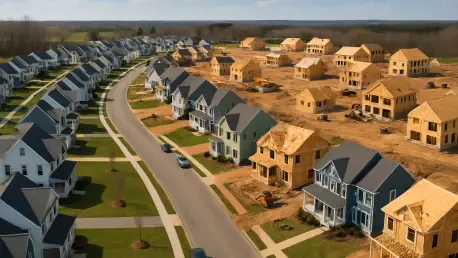In a striking turn of events, a small suburb near Boston has become a beacon of hope for urban planners and environmentalists alike, demonstrating that ambitious green policies can fuel a housing boom rather than stifle it, and Lexington, Massachusetts, has shattered the myth that stringent environmental standards and multifamily zoning reforms inevitably slow development or inflate costs. Over recent years, this community has permitted an impressive number of new housing units while adhering to cutting-edge sustainability mandates. This remarkable achievement challenges long-held assumptions and offers a glimpse into a future where growth and ecological responsibility are not at odds. Far from deterring developers, Lexington’s approach has sparked a surge in construction, including affordable housing, proving that innovative policies can address both housing shortages and climate concerns simultaneously. This success story is capturing attention as a potential model for other municipalities grappling with similar issues.
Zoning Reforms Fueling Growth
Lexington’s journey began with bold zoning changes that embraced multifamily housing under state guidelines, specifically through compliance with the MBTA Communities law. This initiative aimed to increase housing density near transit hubs, making room for diverse residential projects. Over a short span, the town has greenlit over 1,100 new units, a staggering figure for a suburb of its size. What sets this apart is the integration of affordability mandates within these zoning updates. Developments with 10 to 13 units must allocate 10% to affordable housing for households earning up to 80% of the Area Median Income, while larger projects of 14 or more units are required to reserve at least 15%. Far from being a bureaucratic hurdle, these requirements have encouraged a range of projects, from small infill conversions of commercial spaces to sprawling mixed-use complexes. The result is a vibrant housing landscape that caters to varied income levels without sacrificing momentum in construction activity.
Equally significant is the way zoning flexibility has attracted developers to Lexington despite initial skepticism about regulatory constraints. Critics once argued that such reforms would deter investment by adding layers of complexity to project approvals. However, the reality paints a different picture, with the planning board approving nine distinct developments in record time. These projects span a wide spectrum, including a proposed 312-unit apartment complex with integrated retail space by a prominent developer. Local leaders have noted that the streamlined zoning process, combined with clear affordability guidelines, has created an environment where builders feel confident to invest. This surge in activity underscores a critical point: when thoughtfully designed, zoning reforms can act as a catalyst for growth rather than a barrier. Lexington’s experience suggests that strategic policy adjustments can unlock housing potential in communities previously resistant to density increases.
Green Building Standards Driving Innovation
Parallel to zoning reforms, Lexington has implemented pioneering environmental policies that ban fossil fuel use in new constructions as part of a state-led demonstration program. Effective since last year with minor updates recently, this bylaw enforces high energy-efficiency standards for all new buildings. Rather than hampering development as detractors feared, these strict green mandates have positioned the town as a leader in sustainable urban planning. Developers have adapted by incorporating cutting-edge technologies and designs to meet the rigorous requirements, resulting in over 1,100 housing units built under these eco-friendly guidelines. The inclusion of 160 affordable units within this tally further disproves the notion that green standards inherently raise costs to unaffordable levels. Instead, the policies have fostered innovation, encouraging builders to rethink traditional construction methods in favor of sustainable alternatives.
The broader impact of these environmental rules reveals a surprising synergy with housing expansion goals. Far from alienating developers, the fossil fuel ban and energy-efficiency mandates have spurred interest from firms eager to align with forward-thinking communities. Local officials, including voices from the Affordable Housing Trust, have emphasized that these green policies have accelerated project timelines rather than delayed them. The town’s commitment to sustainability has also drawn positive attention, enhancing its appeal as a desirable place to live and invest. This dual focus on environmental responsibility and housing growth challenges the outdated belief that one must come at the expense of the other. Lexington’s ability to balance these priorities demonstrates that green building standards can serve as a competitive advantage, inspiring other municipalities to consider similar measures as they seek to address both climate and housing crises in tandem.
A Blueprint for Sustainable Urban Progress
Reflecting on Lexington’s achievements, it becomes evident that the town navigated initial concerns with remarkable foresight. Skeptics once warned that combining strict environmental bylaws with zoning reforms would inflate costs and deter builders, yet the past outcomes tell a different story. Over a brief period, the community successfully permitted a diverse array of housing projects while adhering to some of the toughest sustainability standards in the region. The absence of predicted negative impacts—such as stalled developments or unaffordable housing—highlights the effectiveness of a well-coordinated policy framework. Leaders and planners in Lexington proved that with careful planning and stakeholder engagement, ambitious goals could be met without compromise. This track record stands as a testament to the power of innovative governance in addressing complex urban challenges.
Looking ahead, the lessons from Lexington offer actionable insights for other towns and cities facing similar dilemmas. Municipalities should consider adopting integrated strategies that pair zoning flexibility with green building mandates to stimulate housing growth sustainably. State programs and local bylaws can be tailored to incentivize developers while ensuring affordability and environmental goals are met. Collaboration between planning boards, housing trusts, and builders will be crucial to replicate this model elsewhere. Additionally, sharing data and outcomes from successful projects can build confidence among stakeholders wary of change. As urban areas continue to grapple with housing shortages and climate imperatives, Lexington’s experience provides a compelling case for rethinking traditional development paradigms. The path forward lies in embracing policies that harmonize growth with sustainability, ensuring communities thrive for generations to come.









